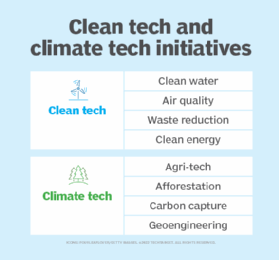
Getty Images
Climate tech vs. clean tech: What's the difference?
Businesses and consumers are becoming more concerned with environmental effects -- and how they can make changes or use clean tech and climate tech to make a difference.
Many people confuse climate tech with clean tech -- but there are differences between the two.
Consumers are looking into human effects on the environment and want to do business with companies that also value the planet. And technology is developing, growing and adapting to the needs of the planet to help lessen the impact. After the 2021 United Nations Climate Change Conference (COP26) event in Glasgow, Scotland, discussing the climate crisis, businesses and governments are looking at ways to combat climate change and other environmental issues -- all while being transparent with consumers on how they plan to address sustainability.
The Paris Agreement signed at the COP21 event in 2015 set long-term goals for national leaders to reduce global greenhouse gas emissions, provide developing countries funding to combat climate change and review commitments every five years. This legally binding treaty set the framework for net-zero goals, limiting greenhouse gas emissions to as close to zero as possible.
Both clean tech and climate tech address environmental impact and deal with existing and future damage to the planet.
What is clean tech?
The term clean tech -- or clean technology -- started when new technologies were offered to investors to help reduce environmental damage back in the early 2000s. Other phrases such as green tech and eco-technology are sometimes used interchangeably with clean tech.
Clean tech describes technology or businesses that offer renewable energy and environmentally friendly alternatives to existing technologies to limit environmental effects. Clean tech addresses soil, water and air pollution caused by "dirty" technologies, such as coal, gas, oil, mining, transportation and manufacturing.
Clean tech can also address energy efficiency in areas such as the following:
- Clean water. Water is essential to human life, but clean water is not universally available. As the global population grows, industries are looking for ways to clean and reuse water so that new sources are not needed. An example of new technology is the portable filters from Innovative Water Technologies that use solar and wind power to clean water from any location.
- Air quality and pollution. The quality of air directly affects health, wildlife and nature. Tracking air quality and pollution can help determine areas people should avoid at times and determine what will affect the air quality.
- Recycling and waste. Dumping waste into the ocean or on the ground presents a problem because space will run out. This directly affects the environment, making it difficult to find clean water. Recycling programs are working to address the problem, but plastics can be hard to recycle when mixed with other chemicals and materials during production. Companies are looking at ways to reduce the use of plastic for more recyclable materials, such as bio-based plastics.
- Clean energy. This technology creates energy from renewable energy sources and zero-emission sources. Examples of popular clean energy include solar panels, wind farms and floating solar panels. There are several green energy sources offering competitive rates and growth, including renewable hydrogen and hydropower.
What is climate tech?
Climate tech deals with technology that combats climate change by mitigating global greenhouse gas emissions. This includes removing greenhouse gases in the environment and reducing future emissions.
Climate tech initiatives include the following:
- Agri-tech. Agri-tech helps mitigate greenhouse gases with initiatives such as reducing livestock manure, using less pesticides and improving crop-growing processes -- for example, by using aeroponics.
- Afforestation. To assist with carbon capture, afforestation creates new forests so that trees can reduce carbon dioxide and add oxygen to the air, reducing greenhouse gas emissions. Organizations work with the timber industry to help restore trees in degraded areas.
- Carbon capture. The main gas contributing to climate change and global heating is carbon dioxide. Capturing carbon and preventing it from going into the environment can help mitigate the effects. Manufacturers are looking for clean energy using carbon capture technology, which takes carbon from the manufacturer, stores it, and turns it into hydrogen for power with minimal or zero greenhouse gas emissions.
- Geoengineering. Also referred to as climate engineering, geoengineering's goal is to alter the climate system to reduce the effects of climate change. One way to do this is to remove carbon dioxide from the atmosphere by capturing the gas and storing it below ground. Solar radiation management is another form of geoengineering that captures and reduces the sun's rays to prevent warming the Earth.
What's the difference between climate tech and clean tech?
Climate tech includes some similar functions to clean tech, but climate tech primarily focuses on greenhouse gas emissions. However, these emissions are only one portion of society's effects on the environment.

Clean tech covers a broader area, including clean water. Clean water is important to the environment and human health, but cleaning water does not reduce greenhouse gas emissions -- making it part of clean tech.
Agri-tech aims to reduce methane and carbon, which both affect greenhouse gas emissions. The primary goal of agri-tech is to develop agriculture methods that are less harmful to the environment by reducing greenhouse gas emissions -- so agri-tech is a part of climate tech.
Here are a few areas of clean tech and climate tech that overlap:
- supply chain
- transportation
- environmentally friendly structures
- clean energy
Why is clean technology important?
Climate change is one of the planetary boundaries that require the world to rethink systems and processes from a technological perspective, according to the Stockholm Resilience Centre. One major initiative is the burning of fossil fuels, which is the world's primary source of energy. Other planetary boundaries for technology to address include land use; freshwater use; ozone depletion; biodiversity loss; ocean acidification; waste; and emission of pollutants such as aerosol, nitrogen and phosphorus into the biosphere and oceans.
Clean technology addresses these problems. Clean tech can help reduce the costs of technology and risks to the environment.
The future and investing in clean technology
Technology can help drive environmental sustainability and is a way to invest in the future of a company. In 2021, $755 billion was invested in clean technology -- a new record, according to BloombergNEF.
Another area of growth for clean tech is in the jobs sector. Two clean tech jobs -- wind turbine technicians and solar photovoltaic installers -- are predicted to have some of the highest job growth rates at 68% and 52%, respectively, from 2020 to 2030, according to the U.S. Bureau of Labor Statistics.
Clean energy could bring half a million new jobs annually through 2035, according to the University of California, Berkeley's 2035 Electric Decarbonization Modeling Study. This report also said the U.S. could reach 90% clean electricity use by 2035 without raising consumer prices.
Companies have also pledged to invest in clean technology. For example, billionaires worldwide -- including Jeff Bezos, Michael Bloomberg, Richard Branson, Ray Dalio, Bill Gates, Reid Hoffman and Mark Zuckerberg -- founded Breakthrough Energy Ventures, helping to capitalize on clean tech funding.
In 2020, Amazon created the Climate Pledge Fund -- a $2 billion investment program to reach its sustainability goals. Microsoft also announced the $1 billion Climate Innovation Fund to invest in environmental protection programs and technology, as well as its goal to be carbon negative by 2030.
Businesses such as Hewlett Packard Enterprise have adopted net-zero goals with carbon emissions management. With technology advancements in AI, machine learning (ML) and data science, agencies and companies can analyze the emerging risks in the environment along with ways to combat climate issues.
Learn how AI and ML can tackle the effects of climate change.
ESG, which stands for environmental, social and governance, is another category in which businesses can invest their money. There is no requirement for businesses to invest in ESG, but investors are using these initiatives to determine which companies they should invest in. Consumers are also choosing to do business with companies that prioritize ESG, so it's vital that companies are aware of ESG trends and work toward sustainability.







